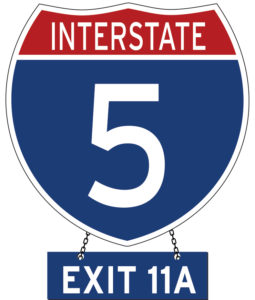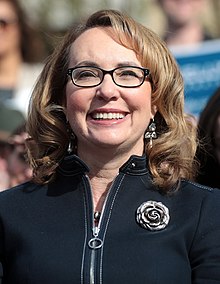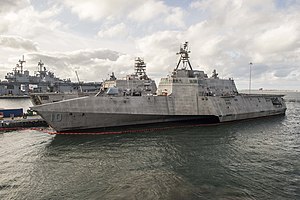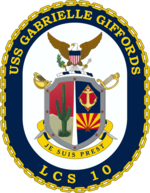Schlepping and Schmoozing Along the Interstate 5, Chapter 15, Exit 11A (Harbor Drive): USS Gabrielle Giffords

 Take Harbor Drive exit; curve north to Naval Base San Diego, for which you need permission to enter. The base’s street address is 3455 Senn Street, San Diego. USS Gabrielle Giffords, when in port, docks at one of the piers in this portion of San Diego Bay.
Take Harbor Drive exit; curve north to Naval Base San Diego, for which you need permission to enter. The base’s street address is 3455 Senn Street, San Diego. USS Gabrielle Giffords, when in port, docks at one of the piers in this portion of San Diego Bay.
It may seem an irony that a Navy warship, the USS Gabrielle Giffords, is named after someone who has become identified with the anti-gun movement. However, in 2012 when then Secretary of the Navy Ray Mabus announced that the tenth Littoral Combat Ship (LCS-10) to come off the line would be named after former Congresswoman Gabrielle Giffords, he explained that Giffords, victim of an attempted assassination in 2011, had “inspired the nation with remarkable resiliency.”

(Photo: Wikipedia)
Married to former Navy astronaut Mark Kelly, a Space Shuttle commander who subsequently was elected as Arizona’s junior U.S. senator, Giffords also was lauded by Mabus as an exemplary Navy spouse.
There was controversy over the choice of her name, as most preceding LCS’s had been named for American cities, including Fort Worth, Coronado, Milwaukee, Jackson, Detroit, Montgomery, and Little Rock. But, as it turned out, the name of Gifford’s hometown, “Tucson,” had already been bestowed upon one of the Navy’s Los Angeles-class submarines. And there were numerous precedents for the Navy departing from its naming conventions for other types of ships. The USS Gabrielle Giffords is the 16th naval ship to be named for a woman and the 13th naval ship to be named for a living person. Among Jews for whom naval ships also have been named are Samuel Gompers, Hyman Rickover, Harvey Milk, and Carl Levin. Another is scheduled to be named for the late Supreme Court Justice Ruth Bader Ginsburg.
Giffords, born June 8, 1970, as the daughter of a Jewish father and Christian Scientist mother, decided as an adult to exclusively practice Judaism as a member of Tucson’s Congregation Chaverim, a Reform congregation. Actress Gwyneth Paltrow and director Jake Paltrow are second cousins on the side of her father, Spencer Giffords.
After studying Latin American History at Scripps College in California and continuing her studies as a Fulbright Scholar in Chihuahua, Mexico, she later earned from Cornell University a master’s degree in Regional Planning and began a career in regional economic development at Price Waterhouse in New York City. But in 1996 she returned to her native Arizona to serve as CEO of a chain of auto service centers founded by her grandfather.
She sold the business in 2000 to Goodyear Tire, changed her political party from Republican to Democrat, and ran successfully for the Arizona House of Representatives. Two years later, she was elected to the Arizona State Senate, at age 32 the youngest woman elected to that body. In 2005, after resigning from the State Senate, she commenced her first campaign for the U.S. House of Representatives, winning in the 8th Congressional District with 54.26 percent of the vote. She and Mark Kelly were married in 2007. In 2008, she slightly improved her winning percentage to 54.72 percent, but in 2010, her last election, she received only 48.76 percent, barely 4,000 votes more than her Republican opponent.
During her tenure, Giffords had launched a Meet-the-Voters program called “Congress on Your Corner,” at which constituents could find her at announced locations within their neighborhoods. On January 8, 2011, she was conducting just such a meeting in front of a Safeway grocery in Casa Adobes, Arizona, when a shooter, later identified as Jared Lee Loughner and sentenced to life in prison, opened fire on the gathering, killing six of the 19 people he shot. Among those murdered was Christina Taylor-Green, the 9-year-old granddaughter of former Major League Baseball manager Dallas Green, who had piloted the Philadelphia Phillies, New York Yankees and New York Mets. Another victim was U.S. District Judge John Roll, who was shot in the back while trying to protect the life of Ron Barber, one of Giffords’ staff members. Judge Roll was a conservative Republican, but partisan differences were unimportant during the attack by the mass murderer. Another member of the Democrat Giffords’ staff, Daniel Hernandez Jr, was credited with saving the congresswoman’s life by providing emergency first aid until she could be taken by ambulance to the University Medical Center of Tucson.
An induced coma, surgeries, and physical therapy followed for Giffords, who recovered sufficiently to travel to the Kennedy Space Center in Cape Canaveral, Florida to watch her husband, Mark Kelly, be launched into space. She returned to the hospital for another surgery, finally being released to go home on June 15, 2011, a little more than six months following the mass shooting. On August 1, she traveled to Washington D.C. to vote in the House to raise the debt limit ceiling. She traveled again on October 6, to attend her husband’s retirement ceremony, at which she presented him with the Distinguished Flying Cross. On January 25, 2012, a year and 17 days after the mass shooting, she received a standing ovation on the Floor of the House before submitting a letter of resignation. As she still had trouble talking because of her injuries, her friend and fellow Jewish congresswoman, Debbie Wasserman-Schultz of Florida, read the letter aloud in her behalf.
Since then, Giffords has appeared at Democratic National Conventions and along with her husband has become a spokesperson for measures to keep guns out of the hands of criminals, terrorists, and the mentally ill. They created Americans for Reasonable Solutions, a political action committee designed to raise awareness of gun control issues and to contribute financially to candidates who favor such laws.

(Photo: Wikipedia)
The Littoral Combat Ship named in her honor has three hulls and is designed to work near shorelines. Gordon R. England, who served from 2003 to 2006 as Secretary of the Navy under President George W. Bush, said the LCS was designed to be “small, fast, maneuverable and relatively inexpensive.” With a modular design, the ship can be reconfigured for such roles as anti-submarine warfare, mine countermeasures, anti-surface warfare, intelligence, surveillance and reconnaissance, homeland defense, maritime intercept, special operations, and logistics. In 2020, it intercepted numerous small boats whose crews were smuggling narcotics.
 With a small flight deck at its stern, the ship can carry helicopters as well as drones, and can launch small boats or vehicles from its ramp. It has missiles, 30-mm gun systems, and is considered ideal for countering small craft that attack in swarms, such as has been experienced in the Persian Gulf.
With a small flight deck at its stern, the ship can carry helicopters as well as drones, and can launch small boats or vehicles from its ramp. It has missiles, 30-mm gun systems, and is considered ideal for countering small craft that attack in swarms, such as has been experienced in the Persian Gulf.
The triple hull (trimaran) of the USS Gabrielle Giffords is one of two designs of an LCS, the other being a more traditional single hull ship. Both classes have shallow drafts enabling them to fight near beaches.
At Naval Base San Diego, which also is known as the 32nd Street Naval Station, the USS Gabrielle Giffords was one of a contingent of 14 Littoral Combat Ships as of 2021. The base was homeport to a total of 54 vessels, also including amphibious assault ships, cruisers, destroyers, and supply and support ships.
Tracing its history back to World War I, the 1,600 acres that comprise today’s Naval Base San Diego, initially housed the private Pacific Marine Construction company. The area was transformed into U.S. Destroyer Base, San Diego under an order issued in 1921 by Acting Secretary of the Navy Theodore Roosevelt Jr., the son of the 26th President of the United States. It underwent major expansion during World War II, when it was redesignated as U.S. Repair Base, San Diego. Following the war, in 1946, it was once again renamed, this time as Naval Station, San Diego. In 1994, the name was changed to its present one “Naval Base San Diego.”
Besides housing the 54 ships, the base is the hub for all other Naval operations in the San Diego region, including the Naval Medical Center and 150 separate tenant commands and support facilities.
While one can glimpse from the Interstate 5 freeway the superstructures of many of the ships at Naval Base San Diego, a far better view of them is from the two-hour sightseeing boats that ply San Diego Bay south of the San Diego-Coronado Bay Bridge. Since the infamous terrorist attacks of September 11, 2001, civilian entry to Naval Base San Diego is no longer permitted without first making mission-specific arrangements with the U.S. Navy.
 *
*
Next Sunday, April 17, 2022: Exit 11B (Plaza Boulevard): International House of Pancakes
This story is copyrighted (c) 2022 by Donald H. Harrison, editor emeritus of San Diego Jewish World. It is a serialization of his book Schlepping and Schmoozing Along Interstate 5, Volume 1, available on Amazon. Harrison may be contacted via donald.harrison@sdjewishworld.com